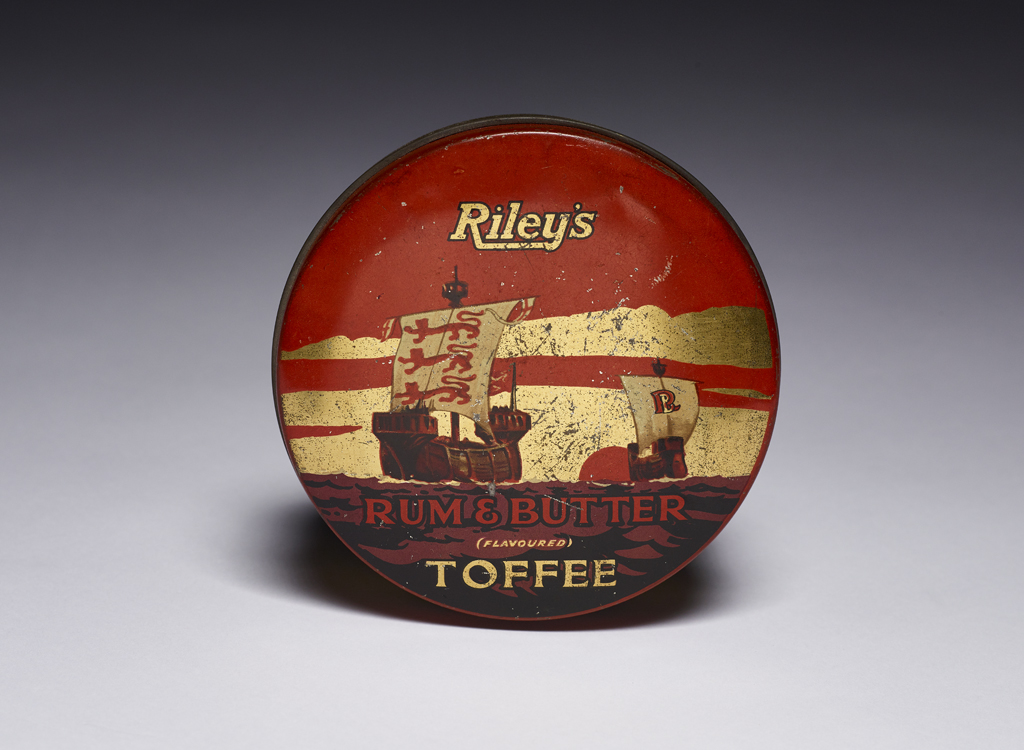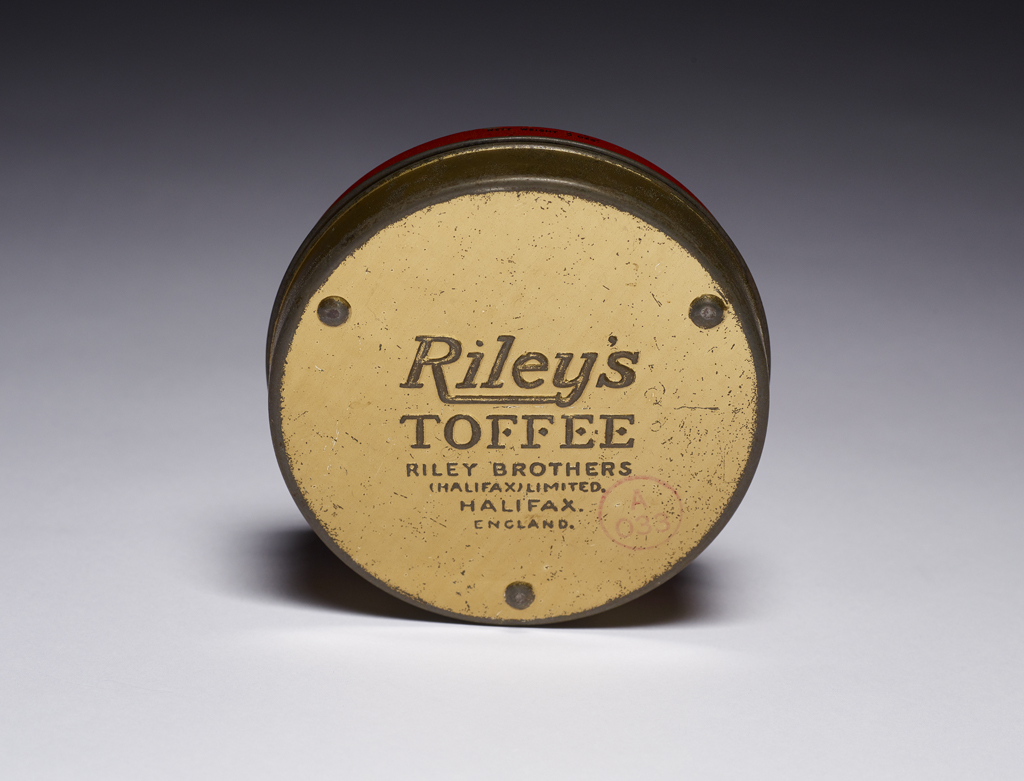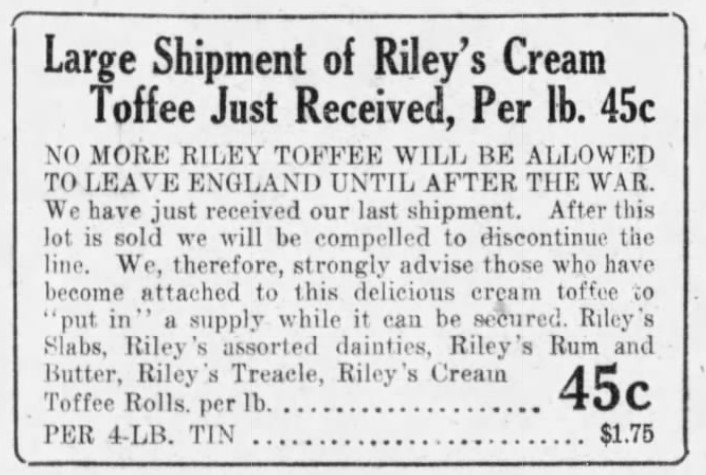In the spirit of Halloween I searched the collection looking for something unique to share. I came across a small candy tin with two ships on the lid. The name across the front said Riley’s Rum and Butter (Flavoured) Toffee, which sounded fun so I started to research.
The British company had fairly humble beginnings on a mother’s dining room table. Ellen Riley was born in 1848 to William and Mary Ann Bates. She worked as a dressmaker until she married John Henry Riley on August 7, 1872. John Henry was a woolstapler, meaning that he sorted and traded wool between the producers and the manufacturers. It kind of sounds like he was a middleman to sort out the details and grade the wool for sale. They had two sons, Frederick William and John Herbert Riley. John Herbert became a bank clerk and Fred initially followed in his father’s footsteps working as a woolstapler by 1901. Those career plans changed a few years later.
Around 1905 Fred and John sat down at Ellen’s table and devised a plan: use their mother’s recipe to create a company. By 1907 they began making the toffee from home, and eventually bought a factory as their success grew. They packaged their candies in decorative tins, which they sold around England.
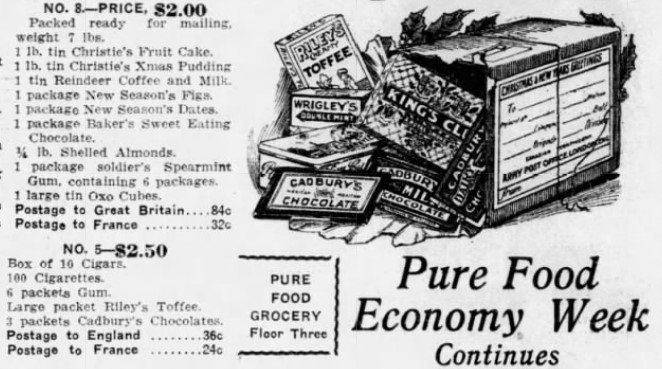
By the time of World War I the company sold candies around the world, with newspapers in 1916 proclaiming “Xmas in the Trenches! What Will it Hold for Your Lad in Khaki?” The care packages they advertised included various assortments of cigarettes, gum, tobacco, Cadbury’s Chocolates, cigars, and packets of Riley’s Toffee. (See a theme there?)
One Canadian ad in 1917 announced, “We, therefore, strongly advise those who have become attached to this delicious cream toffee,” to make their order now because no additional shipments would be leaving England until after the war. The ad listed Riley’s Rum and Butter as available and a roll of toffee sold for 45 cents per pound.
In April 1918 the Halifax Evening Courier printed a column which declared, “you cannot enter a house in France or Belgium without finding that the coffee and sugar are kept in ‘Mackintosh’ or ‘Riley’ toffee tins. In many houses these tins are the only ornaments to be seen, except the family crucifix.”
I found this very interesting because you often hear stories of care packages sent to soldiers and sailors with toothpaste and deodorant. When the history mentions sweets the focus is usually on chocolate, whether from Mars, Hershey, or Cadbury. The excitement over toffee is not as large a part of the narrative, though clearly both the soldiers and families at home valued the toffee and their tins during the war years.
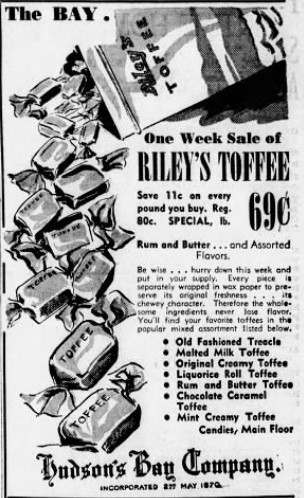
Riley Brothers survived the war and was able to continue on even after the death of Fred in March 1922 while on a trip to Germany. Through WWII the company continued to ship their toffees all over the world, and remained family operated until the death of John in 1953 when the company changed hands. It then passed through several owners until Kraft (the American company) bought it and discontinued the toffees in the mid-1990s.
That could have been the end, but no! Kraft allowed the intellectual property rights to expire, and that’s when Freya Sykes stepped up. Her grandmother, Ella Riley, had given her a cookbook and in it Freya discovered a handwritten recipe. It was the original recipe Ella wrote down for her uncles’ toffee rolls. Freya won the intellectual property rights and in 2009 opened her own company, Ella Riley’s Traditional Sweet Shop, in Wales. As with many small companies in 2020, it appears that the resurgence was brief and their website now only tells the history of the toffee. However, it is exciting to know that the family has the recipe and maintains interest in the tasty history.
The tins that contained the early toffees were very unique, showing stylized alphabets, fairy tales, royal families, astronauts, and numerous other fanciful scenes. One tin even made a Hollywood appearance in the film version of “Harry Potter and the Half-Blood Prince,” when Dumbledore removes a tin from Tom Riddle’s burning wardrobe.
The tin in our collection features two ships at sea. The sail of one features three lions, and the other has the letters RB (Riley Brothers) intertwined together. In this case the water connects us all, but so does candy!
